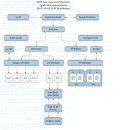- Joined
- Oct 9, 2007
- Messages
- 47,244 (7.55/day)
- Location
- Hyderabad, India
| System Name | RBMK-1000 |
|---|---|
| Processor | AMD Ryzen 7 5700G |
| Motherboard | ASUS ROG Strix B450-E Gaming |
| Cooling | DeepCool Gammax L240 V2 |
| Memory | 2x 8GB G.Skill Sniper X |
| Video Card(s) | Palit GeForce RTX 2080 SUPER GameRock |
| Storage | Western Digital Black NVMe 512GB |
| Display(s) | BenQ 1440p 60 Hz 27-inch |
| Case | Corsair Carbide 100R |
| Audio Device(s) | ASUS SupremeFX S1220A |
| Power Supply | Cooler Master MWE Gold 650W |
| Mouse | ASUS ROG Strix Impact |
| Keyboard | Gamdias Hermes E2 |
| Software | Windows 11 Pro |
AMD "Zen" CPU micro-architecture has a design focus on significantly increasing per-core performance, particularly per-core number-crunching performance, according to a 3DCenter.org report. It sees a near doubling of the number of decoder, ALU, and floating-point units per-core, compared to its predecessor. In essence, the a Zen core is AMD's idea of "what if a Steamroller module of two cores was just one big core, and supported SMT instead."
In the micro-architectures following "Bulldozer," which debuted with the company's first FX-series socket AM3+ processors, and running up to "Excavator," which will debut with the company's "Carrizo" APUs, AMD's approach to CPU cores involved modules, which packed two physical cores, with a combination of dedicated and shared resources between them. It was intended to take Intel's Core 2 idea of combining two cores into an indivisible unit further.

AMD's approach was less than stellar, and was hit by implementation problems, where software sequentially loaded cores in a multi-module processor, resulting in a less than optimal scenario than if they were to load one core per module first, and then load additional cores across modules. AMD's workaround tricked software (particularly OS schedulers) into thinking that a "module" was a "core" which had two "threads" (eg: an eight-core FX-8350 would be seen by software as a 4-core processor with 8 threads).
In AMD's latest approach with "Zen," the company did away with the barriers that separated two cores within a module. It's one big monolithic core, with 4 decoders (parts which tell the core what to do), 4 ALUs ("Bulldozer" had two per core), and four 128-bit wide floating-point units, clubbed in two 256-bit FMACs. This approach nearly doubles the per-core number-crunching muscle. AMD implemented an Intel-like SMT technology, which works very similar to HyperThreading.
View at TechPowerUp Main Site
In the micro-architectures following "Bulldozer," which debuted with the company's first FX-series socket AM3+ processors, and running up to "Excavator," which will debut with the company's "Carrizo" APUs, AMD's approach to CPU cores involved modules, which packed two physical cores, with a combination of dedicated and shared resources between them. It was intended to take Intel's Core 2 idea of combining two cores into an indivisible unit further.

AMD's approach was less than stellar, and was hit by implementation problems, where software sequentially loaded cores in a multi-module processor, resulting in a less than optimal scenario than if they were to load one core per module first, and then load additional cores across modules. AMD's workaround tricked software (particularly OS schedulers) into thinking that a "module" was a "core" which had two "threads" (eg: an eight-core FX-8350 would be seen by software as a 4-core processor with 8 threads).
In AMD's latest approach with "Zen," the company did away with the barriers that separated two cores within a module. It's one big monolithic core, with 4 decoders (parts which tell the core what to do), 4 ALUs ("Bulldozer" had two per core), and four 128-bit wide floating-point units, clubbed in two 256-bit FMACs. This approach nearly doubles the per-core number-crunching muscle. AMD implemented an Intel-like SMT technology, which works very similar to HyperThreading.
View at TechPowerUp Main Site




